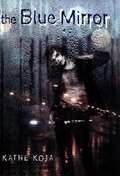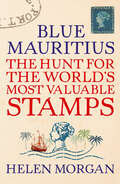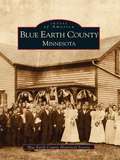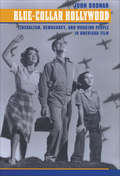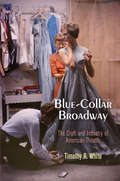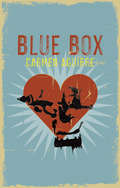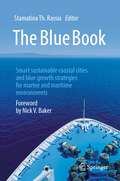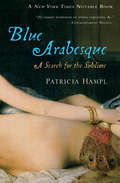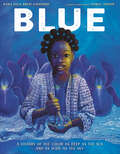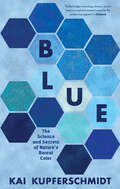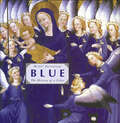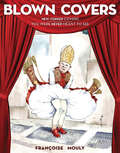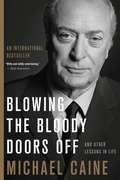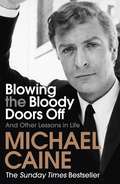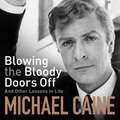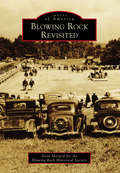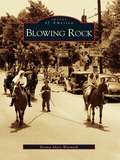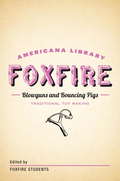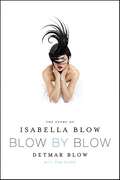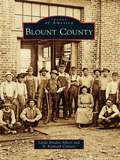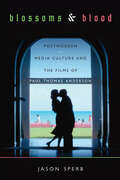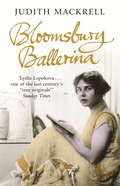- Table View
- List View
The Blue Mirror
by Kathe KojaSeventeen-year-old loner Maggy Klass, who frequently seeks refuge from her alcoholic mother's apartment by sitting and drawing in a local cafe, becomes involved in a destructive relationship with a charismatic homeless youth named Cole.
Blue Mauritius: The Hunt for the World's Most Valuable Stamps
by Helen MorganFollow the adventures of the world's most sought-after postage stamps—from a tropical Indian Ocean island to the hushed atmosphere of the modern auction room—in this dramatic and passionate tale of the first stamp hunters. In September 1847 colored squares of paper were stuck on to envelopes and used to send out admission cards to a fancy-dress ball on the tropical island of Mauritius. No one at the party would have guessed that these stamps would one day be worth more than a million dollars. When a two-pence "Blue Mauritius" surfaced on the fledgling French stamp-collecting market in 1865 it gained instant celebrity. Soldiers, schoolboys, and the entire German nation became obsessed with finding one of these extremely rare examples. When in 1903 a perfect specimen, discovered in a childhood album, was bought at auction by the Prince of Wales, the Blue Mauritius gained superstar status. Even now, "Post Office Mauritius" stamps are synonymous with fame, wealth, and mystery. The most coveted scraps of paper in existence, this is their story—from their birth during days of sail, taking them from Port Louis to Bordeaux, India and Great Britain, Switzerland and Japan, into the hearts and imagination of collectors everywhere.
Blue Earth County, Minnesota
by Blue Earth County Historical SocietyThe first white settlers came to what is now Blue Earth County in 1852, and discovered an abundance of rich land, streams, rivers, and lakes for survival in southern Minnesota. Showcasing photographs from the area's first 70 years, the Blue Earth County Historical Society has compiled over 200 images of the lifestyles and advancements of its earliest settlers.The pioneers of Blue Earth County recognized the potential for success at the bend in the Minnesota River, and forged a vibrant community out of the big woods and prairies of southern Minnesota. Pictured here are the fruits of those settlers' labors, seen in vintage images from the townships of Blue Earth County, including life on the farms and in the towns.
Blue-Collar Hollywood: Liberalism, Democracy, and Working People in American Film
by John BodnarSelected by Choice Magazine as an Outstanding Academic Title for 2003From Tom Joad to Norma Rae to Spike Lee's Mookie in Do the Right Thing, Hollywood has regularly dramatized the lives and struggles of working people in America. Ranging from idealistic to hopeless, from sympathetic to condescending, these portrayals confronted audiences with the vital economic, social, and political issues of their times while providing a diversion—sometimes entertaining, sometimes provocative—from the realities of their own lives.In Blue-Collar Hollywood, John Bodnar examines the ways in which popular American films made between the 1930s and the 1980s depicted working-class characters, comparing these cinematic representations with the aspirations of ordinary Americans and the promises made to them by the country's political elites. Based on close and imaginative viewings of dozens of films from every genre—among them Public Enemy, Black Fury, Baby Face, The Grapes of Wrath, It's a Wonderful Life, I Married a Communist, A Streetcar Named Desire, Peyton Place, Taxi Driver, Raging Bull, Coal Miner's Daughter, and Boyz N the Hood—this book explores such topics as the role of censorship, attitudes toward labor unions and worker militancy, racism, the place of women in the workforce and society, communism and the Hollywood blacklist, and faith in liberal democracy.Whether made during the Great Depression, World War II, the Cold War, or the Vietnam era, the majority of films about ordinary working Americans, Bodnar finds, avoided endorsing specific political programs, radical economic reform, or overtly reactionary positions. Instead, these movies were infused with the same current of liberalism and popular notion of democracy that flow through the American imagination.
Blue-Collar Broadway
by Timothy R. WhiteBehind the scenes of New York City's Great White Way, virtuosos of stagecraft have built the scenery, costumes, lights, and other components of theatrical productions for more than a hundred years. But like a good magician who refuses to reveal secrets, they have left few clues about their work. Blue-Collar Broadway recovers the history of those people and the neighborhood in which their undersung labor occurred.Timothy R. White begins his history of the theater industry with the dispersed pre-Broadway era, when components such as costumes, lights, and scenery were built and stored nationwide. Subsequently, the majority of backstage operations and storage were consolidated in New York City during what is now known as the golden age of musical theater. Toward the latter half of the twentieth century, decentralization and deindustrialization brought the emergence of nationally distributed regional theaters and performing arts centers. The resulting collapse of New York's theater craft economy rocked the theater district, leaving abandoned buildings and criminal activity in place of studios and workshops. But new technologies ushered in a new age of tourism and business for the area. The Broadway we know today is a global destination and a glittering showroom for vetted products.Featuring case studies of iconic productions such as Oklahoma! (1943) and Evita (1979), and an exploration of the craftwork of radio, television, and film production around Times Square, Blue-Collar Broadway tells a rich story of the history of craft and industry in American theater nationwide. In addition, White examines the role of theater in urban deindustrialization and in the revival of downtowns throughout the Sunbelt.
Blue Box
by Carmen AguirreInterweaving recollections of her revolutionary life in Chile under Augusto Pinochet's regime with her fleeting attempts to realize a "vision" of love in Los Angeles, Carmen Aguirre's one-woman show Blue Box is a fiery proclamation of carnal yearning and social conviction. As ever, Aguirre is assertive, sexy, and wryly political, sharing the sacrifices of her life with humor and courage.Carmen Aguirre is a Vancouver-based theater artist and screen actor who has worked extensively throughout North and South America. She organizes Theatre of the Oppressed workshops and teaches in the acting department at the Vancouver Film School. Her 2011 autobiography, Something Fierce: Memoirs of a Revolutionary Daughter, is an award-winning bestseller.
The Blue Book: Smart sustainable coastal cities and blue growth strategies for marine and maritime environments
by Stamatina Th. RassiaThis volume offers a wealth of results written by experts from interdisciplinary fields, contributing on a diversity of topics targeting marine and maritime environmental sustainability in coastal and ocean-related areas. The reader will benefit from the diversity and breadth of topical coverage as well as concepts conveyed from a variety researchers. The book serves as an open knowledge platform combining many aspects of SDG #11 including naval architecture and marine engineering, ecology, biomedical informatics, public health, architecture engineering and building physics, nanotechnology as well as advanced technologies, innovation and related fields. The broad range of topics cover ecology, shipping, and health related issues. Specifically, the book presents chapters on the following: · Shipping and ecology · Topics of ocean wildlife and mega-fauna protection · Big Data and sustainable applications for healthy and safe coastal cities · Smart sustainable humanitarian assistance methods using large vessels · Smart coastal city tourist activity, mobility management · Urban climate condition mitigation · Historical analysis of the case of disease outbreaks onboard ships · Monitoring, simulating and decision making while developing housing at sea, such as in cruise-ships · Conducting feasibility assessment for outbreak prevention following real-time, systematic disease detection on cruise ships · Technological approaches for cruise ship disease propagation monitoring · Scenario testing for sensors and actuators deployment to prevent and mitigate epidemics on cruise ships, as well as methods for improving biological safety on ships using nanotechnology The book is expected to engage researchers in multidisciplinary areas as well as students and interested readers.
The Blue Bear
by Lynn schoolerHis body twisted by adolescent scoliosis, Lynn Schooler's soul was scarred from the loneliness of someone who, at an early age, stood 'at a strange angle to the rest of the world'. He made a life on the slim crescent of remote Alaskan coastline surrounding the city of Juneau, a place where he was least likely to encounter people. In 1990, celebrated Japanese photographer Michio Hoshino hired Schooler to help him shoot a segment on humpback whales in Glacier Bay, and the two formed a profound friendship. Their conversations often revolved around the glacier bear (known as the blue bear for its unique granite-coloured fur), a nearly extinct creature so rare that it is shrouded in legend. Together the two men became obsessed with finding the animal, every year searching through Ice-Age vistas to capture the blue bear on film. Their obsession cost Hoshino his life when he was killed by a grizzly bear - but alone in the eighth year, Schooler finally found and photographed the elusive creature.
Blue Arabesque: A Search for the Sublime
by Patricia HamplJust out of college, Patricia Hampl was mesmerized by a Matisse painting in the Art Institute of Chicago: an aloof woman gazing at goldfish in a bowl, a Moroccan screen behind her. In Blue Arabesque, Hampl explores the allure of this lounging woman, immersed in leisure, so at odds with the rush of the modern era. Hampl's meditation takes us to the Cote d'Azur and to North Africa, from cloister to harem, pondering figures as diverse as Eugene Delacroix, F. Scott Fitzgerald, and Katherine Mansfield. Returning always to Matisse's portraits of languid women, she discovers they were not decorative indulgences but something much more. Moving with the life force that Matisse sought in his work, Blue Arabesque is Hampl's dazzling and critically acclaimed tour de force.
Blue: A History of the Color as Deep as the Sea and as Wide as the Sky
by Nana Ekua Brew-HammondDiscover a world of creativity and tradition in this fascinating picture book that explores the history and cultural significance of the color blue. From a critically acclaimed author and an award-winning illustrator comes a vivid, gorgeous book for readers of all ages.NAMED ONE OF THE BEST BOOKS OF THE YEAR BY NPR For centuries, blue powders and dyes were some of the most sought-after materials in the world. Ancient Afghan painters ground mass quantities of sapphire rocks to use for their paints, while snails were harvested in Eurasia for the tiny amounts of blue that their bodies would release. And then there was indigo, which was so valuable that American plantations grew it as a cash crop on the backs of African slaves. It wasn't until 1905, when Adolf von Baeyer created a chemical blue dye, that blue could be used for anything and everything--most notably that uniform of workers everywhere, blue jeans.With stunning illustrations by Caldecott Honor Artist Daniel Minter, this vibrant and fascinating picture book follows one color's journey through time and across the world, as it becomes the blue we know today.
Blue: The Science And Secrets Of Nature's Rarest Color
by Kai KupferschmidtWhat is it about the color blue? Blue is our favorite color globally—the darling of artists since the time of the pharaohs. So it’s startling to turn to the realms of nature and discover that “true” blue is truly rare. The sea and sky are blue, but we can’t bottle this trick of physics. And the few creatures, plants, and minerals that appear blue are almost all deceiving us. There’s no blue pigment in a blue jay—it would be brown but for how its feathers distort light. Kai Kupferschmidt has been enraptured by blue since childhood. In Blue, he invites readers on his globe-trotting quest to understand his favorite color— from Kyoto, where scientists are trying to engineer a blue rose, to Brandenburg, where conservationists hope to save the “little blue macaw.” Deep underground where blue crystals grow and miles overhead where astronauts gaze at our “blue marble” planet-wherever he finds this alluring color, it has a story to tell.
Blue
by Museum of Fine Arts, BostonBlue, the world's favorite color, is elegantly showcased in more than 200 artworks from the collection of the Museum of Fine Arts, Boston. Representing a diversity of movements, cultures, and media that spans the ages and the globe, the objects in Blue range from ancient Egyptian jewelry and traditional Japanese prints to Impressionist paintings and indigo-dyed textiles. Short essays from museum curators on the significance and symbolism of the color at various times and places provide historical context for this visual feast. With page edges dyed blue, this distinctive volume is a bijou treasure.
Blue: Cobalt to Cerulean in Art and Culture
by Museum of Fine Arts Boston<p>Blue, the world's favorite color, is elegantly showcased in more than 200 artworks from the collection of the Museum of Fine Arts, Boston. Representing a diversity of movements, cultures, and media that spans the ages and the globe, the objects in Blue range from ancient Egyptian jewelry and traditional Japanese prints to Impressionist paintings and indigo-dyed textiles. <p>Short essays from museum curators on the significance and symbolism of the color at various times and places provide historical context for this visual feast. With page edges dyed blue, this distinctive volume is a bijou treasure. <p>This is a fixed-format ebook, which preserves the design and layout of the original print book.</p>
Blue: The History of a Color
by Michel PastoureauA beautifully illustrated visual and cultural history of the color blue throughout the agesBlue has had a long and topsy-turvy history in the Western world. The ancient Greeks scorned it as ugly and barbaric, but most Americans and Europeans now cite it as their favorite color. In this fascinating history, the renowned medievalist Michel Pastoureau traces the changing meanings of blue from its rare appearance in prehistoric art to its international ubiquity today. Any history of color is, above all, a social history. Pastoureau investigates how the ever-changing role of blue in society has been reflected in manuscripts, stained glass, heraldry, clothing, paintings, and popular culture. Beginning with the almost total absence of blue from ancient Western art and language, the story moves to medieval Europe. As people began to associate blue with the Virgin Mary, the color became a powerful element in church decoration and symbolism. Blue gained new favor as a royal color in the twelfth century and became a formidable political and military force during the French Revolution. As blue triumphed in the modern era, new shades were created and blue became the color of romance and the blues. Finally, Pastoureau follows blue into contemporary times, when military clothing gave way to the everyday uniform of blue jeans and blue became the universal and unifying color of the Earth as seen from space.Beautifully illustrated, Blue tells the intriguing story of our favorite color and the cultures that have hated it, loved it, and made it essential to some of our greatest works of art.
Blown Covers: New Yorker Covers You Were Never Meant to See
by Françoise MoulyThe art director of The New Yorker serves up“a delicious forbidden taste of the art that didn’t quite nail it, or nailed it a bit too hard” (The Marginalian). Françoise Mouly takes us behind the scenes at The New Yorker and reveals how the magazine creates its signature covers commenting on the most urgent political and cultural events of the day. She shows the shocking and hilarious sketches that didn’t make the cut and explains how these are essential stages in the evolution of a cover that stands the test of time but retains its edge. Her book captures contemporary history—from the farce of Monica Lewinsky to the adventures of Michelle and Barack to nuclear meltdown in Japan—in images that are as acute as they are outrageous. More than that, it shows how the magazine that exemplifies journalistic excellence in America also dares to cultivate a sense of humor when grappling with complex moral and political issues.“Interesting failures are the driving force behind Blown Covers . . . paging through this book is like standing in the corner of her office as she pins up rejected covers on the wall. Mouly has dozens of tales about images that failed for one reason or another. Now, presumably with the approval of her bosses at Condé Nast, she has created a tell-all (or tell-most) that even non–illustrators and designers will find enlightening.” —The New York Times Book Review“Yes, Blown Covers sometimes offends—and that’s the audacious joy of it.” —NPR.org“Offers some true delights.” —The Sacramento Bee“Reveals the shocking and hilarious sketches that didn’t make the cut.” —Patch
Blowing the Bloody Doors Off: And Other Lessons in Life
by Michael CaineWith over 100 movies and two Academy Awards to his credit over six decades, Hollywood legend Michael Caine shares the wisdom, stories, insight, and skills that life has taught him in his remarkable career--and now his 85th year. One of our best-loved actors Michael Caine has starred in a huge range of films from the classic movies Alfie, Zulu, and The Italian Job (the inspiration for the book title) to the Hollywood blockbusting Dark Knight trilogy, Dirty Rotten Scoundrels, Hannah and Her Sisters, and Cider House Rules. Caine has excelled in every kind of role--with a skill that's made it look easy. He knows what success takes--he's made it to the pinnacle of his profession from humble origins. But as he says, "Small parts can lead to big things. And if you keep doing things right, the stars will align when you least expect it." Now in his 85th year--and more beloved than ever--he wants to share everything he's learned. With brilliant new insight into his life and work and showcasing his wonderful gift for storytelling, Blowing the Bloody Doors Off is Caine at his wise and entertaining best.
Blowing the Bloody Doors Off: And Other Lessons in Life
by Michael Caine'Wise, funny' Daily Mail'Chatty and engaging . . . he often comes across as endearingly humble' Sunday Times'Thoroughly engaging' Sunday Express magazine'Fabulous storytelling' PrimaOne of 'the top 25 most compelling Hollywood autobiographies' -GuardianHollywood legend and British national treasure Sir Michael Caine shares the wisdom, stories, insight and skills that life has taught him in his remarkable career - and now his 85th year.One of our best-loved actors Michael Caine has starred in a huge range of films - including all-time favourites - from the classic British movies Alfie, Zulu and The Italian Job to the Hollywood blockbusting Dark Knight trilogy, Dirty Rotten Scoundrels, Hannah and Her Sisters and Cider House Rules. Caine has excelled in every kind of role - with a skill that's made it look easy. He knows what success takes - he's made it to the top of his profession from the toughest beginning. But as he says 'Small parts can lead to big things. And if you keep doing things right, the stars will align when you least expect it.' Now in his 85th year he wants to share everything he's learned.With brilliant new insight into his life and work and with his wonderful gift for story, this is Caine at his wise and entertaining best.
Blowing the Bloody Doors Off: And Other Lessons in Life
by Michael CaineWith over 100 movies to his credit over 5 decades, Hollywood legend and British national treasure Michael Caine shares the wisdom, stories, insight and skills for success in life that acting has taught him in his remarkable career.One of our best-loved actors Michael Caine has starred in everything from classic British films Alfie, Zulu and The Italian Job to the Hollywood blockbusting The Dark Knight trilogy and much-loved movie favourites Dirty Rotten Scoundrels, Hannah and Her Sisters and The Quiet American. Caine has excelled in every kind of role - with a skill that's made it look easy. Acting has taught him as much about life as it has his craft. He knows what success takes - not just luck but hard work and preparation. He also knows that it doesn't stop when you're successful. As he says, 'When you reach the top, that's when the climb begins'. Now he wants to share everything he knows.Bringing brilliant new insight into his life and work and with his wonderful gift for story, this is Caine at his wise and entertaining best.(P)2018 Hodder & Stoughton Limited
Blowing Rock Revisited
by Trent Margrif Blowing Rock Historical SocietyVoted "the Prettiest Small Town in North Carolina" and often referred to as the Crown of the Blue Ridge, Blowing Rock is the highlight of the High Country. Named for a unique, natural feature itself, Blowing Rock has always represented a distinctive blend of natural and cultural heritage. The town was first developed as an early resort area, which grew quickly in the 1890s. Modern boardinghouses, hotels, and inns were the first significant businesses in Blowing Rock and helped the town survive--even flourish--during the Great Depression. Added attractions in the 1950s and 1960s made Blowing Rock a year-round vacation paradise for families, which it still is today. Yet the heart of Blowing Rock lies within its community and residents who make their small town a wonderful place to visit and an even better place to live.
Blowing Rock
by Donna Akers WarmuthThe beautiful and mountainous area of Blowing Rock, North Carolina, has a rich history dating back to the days when the Native Americans passed through on the Nickajack Trail, which led into Tennessee. The town derives its unique name from a rock outcropping near the town, where the winds defy gravity and have the ability to blow light objects thrown from the rock back to the rock. During the 1790s, several families settled the area, and by the mid-1850s, inhabitants of Blowing Rock along with summer visitors from Lenoir enjoyed the beauty and comfort of the mountainous area. The construction of the Lenoir-Blowing Rock Turnpike after 1845 provided easier access to "America's Switzerland," and visitors or "cottagers," as they were called, soon began building second homes in the area. The images contained within Blowing Rock provide readers with a glimpse into the small-town charm, friendly faces, and inspiring scenery that ensure the town's future as a destination for those who yearn for the comfort of mountain life.
Blowguns and Bouncing Pigs: The Foxfire Americana Library (6) (The Foxfire Americana Library)
by Inc. Foxfire FundThe Foxfire Americana Library takes you back to the good ol' days with a collection of simple, classic toys that can be made at home. Complete with illustrated step-by-step instructions, "Blowguns and Bouncing Pigs" includes advice on how to make: Ball and CupsBlowgunsBouncing PigsBows and ArrowsBubble BlowersBull GrindersButtons on a StringClimbing BearsCorn GunsCornstalk AnimalsCornstalk FiddleApple-head DollsCucumber DollsFluttermillsFly GunsHoopsJumping JacksKicking MulesLimberjacksPop GunsPuzzlesRattletrapsRolling ClownsSling ShotsSmoke GrindersSquirt GunsStick HorsesStiltsGrapevine SwingsRope SwingsTops or DancersWhimmy Diddles or Jeep SticksHollow WhistlesSplit WhistlesWhittled Animals
Blow by Blow: The Story of Isabella Blow
by Detmar Blow Tom Sykes“One of the most original and influential people of the twentieth century to me and many others.” —Alexander McQueenWith a career spanning thirty years in fashion, as an influential voice at Vogue, Tatler, and The Sunday Times Magazine—as well as a legacy as one of the industry’s kingmakers for discovering Philip Treacy, Alexander McQueen, Sophie Dahl, and Hussein Chalayan—Isabella Blow had been a pillar of couture culture until her suicide in 2007 left the fashion world mourning one of its finest friends and patrons. Blow by Blow is a captivating journey through Issie’s life, a one-of-a-kind look at her unforgettable impact on the fashion world, and a moving exploration of her inspiring and ultimately tragic tale.
Blount County (Images of America)
by B. Kenneth Cornett Linda Braden AlbertBlount County is the 10th county formed in the state of Tennessee. It was carved out of Knox County in 1795 and named for William Blount, the governor of the Territory South of the River Ohio. Maryville is the county seat and was named for Blount's wife, Mary Grainger Blount. The abundance of natural resources that once drew hardy settlers now attracts tourists from all over the world, especially to Cades Cove, a pioneer settlement in the Blount County section of Great Smoky Mountains National Park. Blount County has been home to the legendary Sam Houston; U.S. Senator Lamar Alexander, who also served as Tennessee's governor; and Bessie Harvey, a world-renowned folk artist.
blossoms & blood: Postmodern Media Culture and the Films of Paul Thomas Anderson
by Jason SperbFrom his film festival debut Hard Eight to ambitious studio epics Boogie Nights, Magnolia, and There Will Be Blood, Paul Thomas Anderson's unique cinematic vision focuses on postmodern excess and media culture. In Blossoms and Blood, Jason Sperb studies the filmmaker's evolving aesthetic and its historical context to argue that Anderson's films create new, often ambivalent, narratives of American identity in a media-saturated world. Blossoms and Blood explores Anderson's films in relation to the aesthetic and economic shifts within the film industry and to America's changing social and political sensibilities since the mid- 1990s. Sperb provides an auteur study with important implications for film history, media studies, cultural studies, and gender studies. He charts major themes in Anderson's work, such as stardom, self-reflexivity, and masculinity and shows how they are indicative of trends in late twentieth-century American culture. One of the first books to focus on Anderson's work, Blossoms and Blood reveals the development of an under-studied filmmaker attuned to the contradictions of a postmodern media culture.
Bloomsbury Ballerina: Lydia Lopokova, Imperial Dancer and Mrs John Maynard Keynes
by Judith MackrellThe story of the splendidly unpredictable Russian dancer who ruffled the feathers of the Bloomsbury set and became the wife of John Maynard KeynesBorn in 1891 in St Petersburg, Lydia Lopokova lived a long and remarkable life. Her vivacious personality and the sheer force of her charm propelled her to the top of Diaghilev's Ballet Russes. Through a combination of luck, determination and talent, Lydia became a star in Paris, a vaudeville favourite in America, the toast of Britain and then married the world-renowned economist, and formerly homosexual, John Maynard Keynes.Lydia's story links ballet and the Bloomsbury group, war, revolution and the economic policies of the super-powers. She was an immensely captivating, eccentric and irreverent personality: a bolter, a true bohemian and, eventually, an utterly devoted wife.
